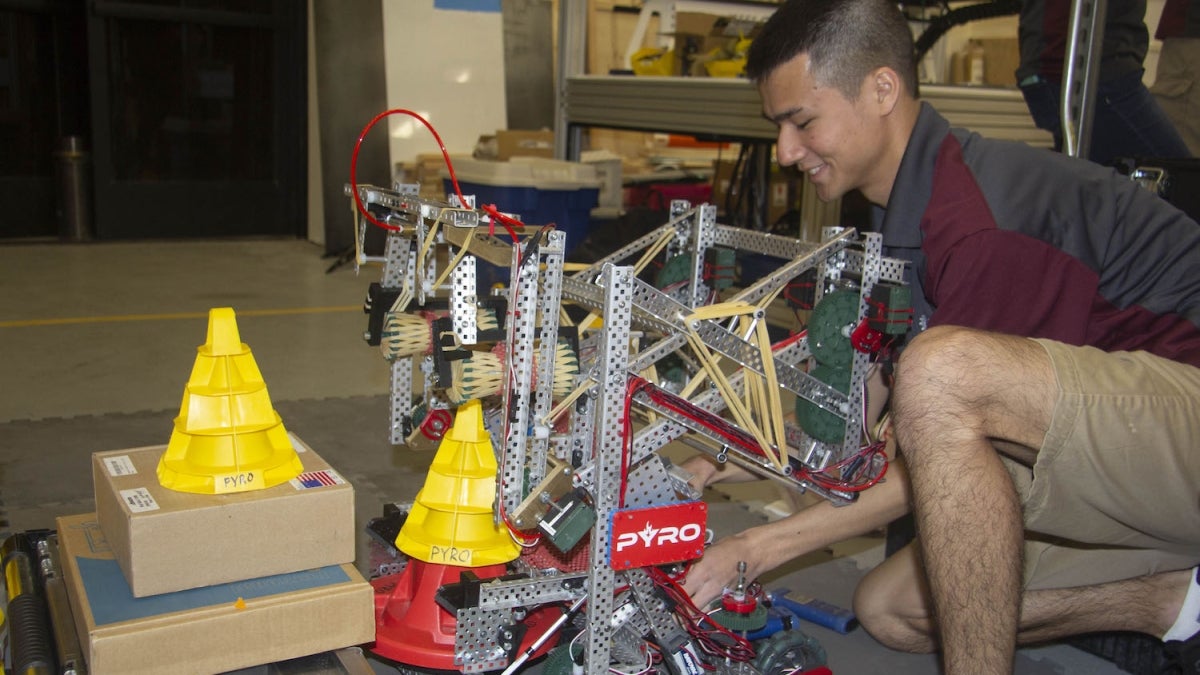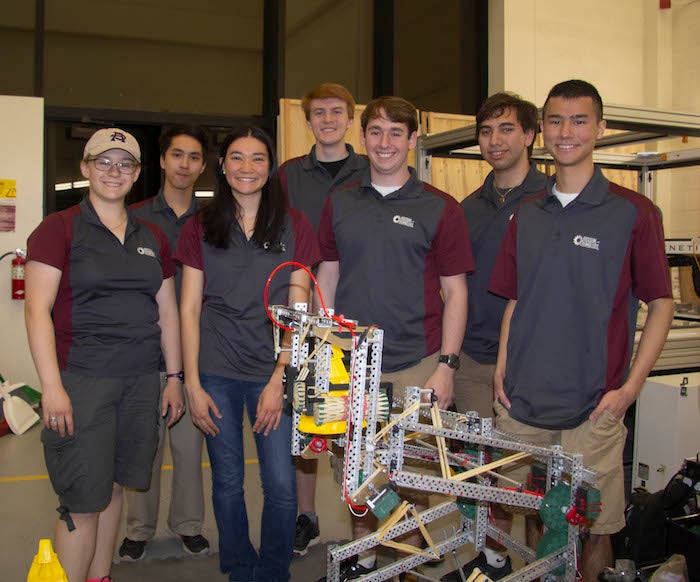ASU robotics club ready to rumble at world championship

Ryan Bodhipaksha, a robotics engineering major at ASU and co-lead of PYRO Robotics, practices with the team’s robot to prepare for the 2018 VEX Robotics World Championship. Photo courtesy of Samantha Blokker
Nearly a year of game strategizing and robot building culminated in the chance for Arizona State University’s Rossum Rumblers Robotics Club to claim the 2018 VEX Robotics World Championship.
At the competition April 25–28, teams competed in matches to score the highest points by having their robots stack cones on goals, move cones into score zones, build the highest stacks and park in designated spaces. Matches consisted of driver-controlled play and an autonomous period on a square field.
“We spent the summer working on the strategy of the game,” said Nathan Rossi, a mechanical engineering systems major in ASU’s Ira A. Fulton Schools of Engineering and Barrett, The Honors College. “Since the robot has to play a game, just like with any sport, there’s going to be an ideal strategy. We analyzed the game, broke down the point values, determined the best way to play and based our robot design off of it.”
Rossi serves as the co-lead of PYRO Robotics, a part of Rossum Rumblers. The PYRO team participates in VEX Robotics competitions through the college and university division, VEX U. VEX U teams benefit from more customization and greater flexibility with robot design than other grade levels, but are also challenged with real-world limitations of a restricted development environment.
Once confident with their game strategy, the team engineered prototypes for individual functions. For instance, the robot needed to be capable of picking up cones. After specifically tailoring mechanisms for certain tasks, the team combined all the best prototypes into one comprehensive vision for the robot.
“One of the most valuable things I’ve learned so far is the significance of communication,” said Ryan Bodhipaksha, robotics engineering major and co-lead of PYRO Robotics. “A successful team functions best if team members are able to reliably understand what other team members are communicating and effectively convey their own ideas and concepts.”
In March, PYRO competed in the Southwest VEX U Regional Qualifier. They became the tournament champions and won the design award, which qualified the team for the VEX Robotics World Championship — the Guinness World Record holder for the largest robotics competition on Earth.
Robotics engineering majors Jonathan Nguyen, Andrew Fechter and Ben Levine helped design and build a secondary robot for the autonomous period of competition. In autonomous mode, there’s no driver controlling the robot; rather, the robot relies on sensors to detect its surroundings and programming to complete designated tasks. Nguyen and Levine focused on replicating the design from the March competition.
“I’ve learned how to overcome my frustration with building and programming and turn it into productivity through collaborative efforts with my team,” Levine said.
As part of the Rossum Rumblers, the PYRO team has support from the entire club. Whether someone gets stuck on a programming issue or can’t think of a creative way to overcome an obstacle, they can rely on other team members with varying levels of experience and different engineering specialties.
“The Rossum Rumblers provide a great resource for PYRO,” Rossi said. “There are so many club members with diverse robotics experiences. They help expand our knowledge and offer helpful suggestions to better work on this project.”
More than 85 teams competed in the 2018 VEX Robotics World Championship, which was hosted in Louisville, Kentucky. The PYRO team placed 10th in the world at the competition.
“We did very well for it being our first time at the world championship,” said Aaron Dolgin, an electrical systems engineering major and outreach coordinator for the Rossum Rumblers. “We are all very excited about the new game and can’t wait to start designing a new robot for next year.”
Rumbling beyond the competition
The PYRO team and other members of the Rossum Rumblers also partake in a variety of other projects and initiatives. For instance, one of the club’s most recent projects was finding a solution for the Fiesta Bowl’s Running of the Bills Duck Race. The club partnered with the Fiesta Bowl and the Salt River Project utility company to create a contraption for the Scottsdale Waterfront Canal to stop 15,000 rubber ducks from floating past the finish line.
Arizona State University’s Rossum Rumblers PYRO Team: (from left to right) Olivia Pinkowski, Jonathan Nguyen, Rachel Fisher, Andrew Fechter, Nathan Rossi, Ben Levine and Ryan Bodhipaksha. Not pictured: Coach Aaron Dolgin and member Analisa Benites. Photo courtesy of Samantha Blokker
Currently, the robotics club is also working on refurbishing a computer-controlled milling machine and a retired military explosive ordnance device called Deltron, which was donated to the university when it acquired the Polytechnic campus and given to Rossum Rumblers.
The Rossum Rumblers take the Deltron robot to a variety of outreach events, another main priority for the club and its members. Since the club’s inception, the Rossum Rumblers have been a consistent presence at ASU’s Homecoming and Open Door events to teach children about the importance of STEM fields.
“We encourage the hands-on application of STEM in academia and industry through innovation, creativity and entrepreneurship,” Dolgin said. “Our motto is automating, building and thinking. What we’re trying to do is create a community of thinkers and makers who can make the world better.”
The club also works on smaller projects that benefit its members. For instance, the club is teaching members about printed circuit board design to encourage their creativity and prepare them for their coursework. They also plan to invite industry sponsors to help members with professional development and give them a competitive advantage in seeking internships and future jobs.
“I really enjoy the environment of the club,” said Rachel Fisher, a chemical engineering major and student in Barrett, The Honors College. “Learning how to think critically and solve challenges, such as the ones presented in competition, mimics the process of building and designing robots as a job. These are incredibly important skills for the future as everything becomes more automated.”
All team members agree that robotics will have a big impact on the future. Software and physical robots may one day perform many day-to-day tasks faster with greater precision and accuracy than humans, which will be economically beneficial for society, said Rossi.
“Robotics can be found in manufacturing, medicine and military, with more uses being developed every day,” Bodhipaksha said. “This field integrates technology to improve society and people’s lives in a safe, constructive and intuitive manner.”
The Rossum Rumblers hope to help make robots’ transition into everyday life just a little easier.
More Science and technology

ASU postdoctoral researcher leads initiative to support graduate student mental health
Olivia Davis had firsthand experience with anxiety and OCD before she entered grad school. Then, during the pandemic and as a…

ASU graduate student researching interplay between family dynamics, ADHD
The symptoms of attention deficit hyperactivity disorder (ADHD) — which include daydreaming, making careless mistakes or taking…

Will this antibiotic work? ASU scientists develop rapid bacterial tests
Bacteria multiply at an astonishing rate, sometimes doubling in number in under four minutes. Imagine a doctor faced with a…
